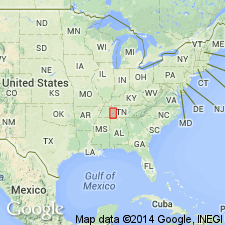
- Usage in publication:
-
- Brownsport bed
- Modifications:
-
- Named
- Dominant lithology:
-
- Limestone
- Clay
- AAPG geologic province:
-
- Cincinnati arch
- Upper Mississippi embayment
Summary:
Newly named Brownsport bed of western TN and northern MS is composed of 120 ft of richly fossiliferous white limestones and calcareous clays. Overlies Dixon red clays and forms top of Silurian section in Tennessee River Valley. Unconformably underlies Linden formation (Helderbergian), or where that is absent, the younger Hardin sandstone. Age is Silurian (Niagaran).
Source: GNU records (USGS DDS-6; Reston GNULEX).

- Usage in publication:
-
- Brownsport formation*
- Modifications:
-
- Revised
- AAPG geologic province:
-
- Cincinnati arch
- Upper Mississippi embayment
Summary:
Foerste's (1903) original definition included beds of Cayugan age at the top of the Brownsport, later separated under the name Decatur limestone by Pate and Bassler (1908). As of this printing [ca. 1938], the Brownsport formation is subdivided into ascending Beech River shaly limestone member, Bob crystalline limestone member, and Lobelville shaly limestone member. Overlies Dixon earthy limestone member of Wayne formation.
Source: GNU records (USGS DDS-6; Reston GNULEX).
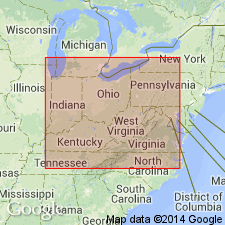
- Usage in publication:
-
- Brownsport group
- Modifications:
-
- Revised
- AAPG geologic province:
-
- Cincinnati arch
Summary:
Chart 3. Brownsport group. Shown on correlation chart as comprising (ascending) Beech River formation, Bob formation, Lobelville formation, and Decatur limestone. [Age is Middle Silurian.]
Source: US geologic names lexicon (USGS Bull. 1200, p. 497-498).
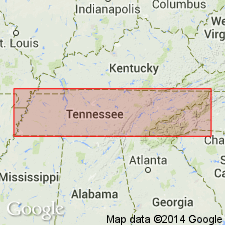
- Usage in publication:
-
- Brownsport formation
- Modifications:
-
- Revised
- AAPG geologic province:
-
- Cincinnati arch
- Upper Mississippi embayment
Summary:
Described in Decatur, Perry, Wayne, and Hardin Cos., TN, as Brownsport formation. Consists of about 100 ft of thin-bedded argillaceous limestones and calcareous shales with lenses of thick-bedded nonargillaceous limestone. Overlies Dixon formation with apparent conformity; underlies Decatur limestone with apparent conformity. Present investigation does not reveal any satisfactory lithologic or faunal basis for division of Brownsport into formations or members, and it is proposed that terms Beech River, Bob and Lobelville be abandoned.
Source: GNU records (USGS DDS-6; Reston GNULEX).
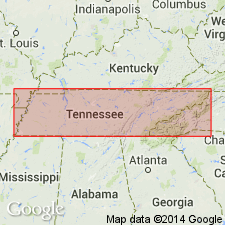
- Usage in publication:
-
- Brownsport group
- Modifications:
-
- Areal extent
- AAPG geologic province:
-
- Cincinnati arch
Summary:
Pg. 257-270, fig. 2. Brownsport group. From a study of Foerste's descriptions of his Brownsport bed, it is apparent that he included all the beds that today comprise the Beech River, Bob, Lobelville, and Decatur formations. Brownsport group as used in this report includes these four units as formations. Overlain by formations of the Devonian or by Chattanooga shale; overlies Wayne group. [Age is Middle Silurian.]
Source: US geologic names lexicon (USGS Bull. 1200, p. 497-498).
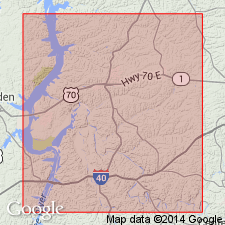
- Usage in publication:
-
- Brownsport Formation*
- Modifications:
-
- Biostratigraphic dating
- AAPG geologic province:
-
- Cincinnati arch
Summary:
Silurian Brownsport Formation used in du Pont Geohydrological Survey well near Waverly, Humphreys Co. central TN. Includes Beech River Member, Bob Limestone Member, and Lobelville Member. PSEUDOONEOTODUS BICORNIS? at 607.4 to 608.4 ft, in Bob Limestone Member, could indicate an early Ludlovian or older Wenlockian age at this level. Overall age of Brownsport is Wenlockian to Pridolian. [See also articles by Broadhead and Gibson in this volume for excellent overviews of Brownsport and its members.]
Source: GNU records (USGS DDS-6; Reston GNULEX).
For more information, please contact Nancy Stamm, Geologic Names Committee Secretary.
Asterisk (*) indicates published by U.S. Geological Survey authors.
"No current usage" (†) implies that a name has been abandoned or has fallen into disuse. Former usage and, if known, replacement name given in parentheses ( ).
Slash (/) indicates name conflicts with nomenclatural guidelines (CSN, 1933; ACSN, 1961, 1970; NACSN, 1983, 2005, 2021). May be explained within brackets ([ ]).

